
|
Sale 46
The Millennia Collection
| Lot |
Photo |
Description |
Realized |
Lot 621 |
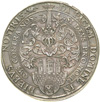 |
German States -- Lüneburg. Double Reichstaler, ND (c 1612). Dav-342a; Schnee-34. Mintmaster Jonas Georgens. Plumed helmet over city arms, fortress below with portcullis gate. Reverse: St John the Baptist pointing to Christ as a recumbent lamb, upon the Gospels; at left, "man in the moon" watching over all. Finely struck on a full flan, elegant "old collection" lavender and gray toning. Very rare. NGC graded EF-45.
Estimated Value $4,000 - 5,000.
View details and enlarged photos
| Realized
$4,830 |
Lot 622 |
 |
Lüneburg. Goldgulden, ND (1650). Fr-1527; KM-39. 3.42 grams. 22.67 mm. No ruler name. Obv: St. John standing, holding lamb, rampant lion in shield at feet. Leg: :MONETA: -- LVNEBEVR: Reverse Crescent moon with profile face right within beaded circle. Leg: *VISITAVIT:ROS:ORIEN:EX:ALTO: NGC graded AU-55.
Luneburg, translated, means city of the moon. Hence, the crescent moon design. Few of this type were minted, and even less survived. A great opportunity.
Estimated Value $2,500 - 3,000.
(*).
View details and enlarged photos
| Realized
$3,680 |
Lot 623 |
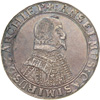 |
German States -- Mainz. Taler, 1636. Dav-5548. Anselm Casimir von Umstadt, 1629-1647. Bust right with pointed beard, in armor. Reverse: Helmeted arms. Lovely blue-violet toning enhances the eye appeal of this elegant taler, well struck on a broad flan. NGC graded MS-63.
An important Roman settlement 2,000 years ago, Mainz's location as a major trading center at the confluence of the Main and Rhine Rivers assured its wealth. The area functioned as a free city of the Empire and as an archbishopric, one of the seven electorates of the Holy Roman Empire. As a trading center, its talers were heavily used, so few survived in better quality. The coin pictured here is a rarity this choice.
Estimated Value $1,250 - 1,500.
Ex Irving Goodman Collection.
View details and enlarged photos
| Realized
$1,955 |
Lot 624 |
 |
Mainz. Ducat, ND (1696). Fr-1666; KM-220. 3.50 grams. 20.76 mm. Mintmaster initials, GFN (Geog Friedrich Nurnberger, in Nuremberg). Lothar Franc, 1695-1729. On the Peace of Ryswick. Concordia seated with corucopia in left arm, crown or wreath of victory in right extened arm. Under figure "CONCORDIA" Reverse Arms under canopy. Leg: L.F.D.G.A - &E.M.E.B. NGC graded MS-61.
The Peace of Ryswick was signed as an end to the war of the grand alliance. Essentially, the nations of England, Netherlands, Spain, and The Holy Roman Empire united to oppose the expansionsit aims of France and Louis XIV. In actuality, the war and the peace treaty accomplished little, yet at the time, was thought of as a great event. Notice that the war was not fought on religious graounds, as two of the Catholic countries opposed Catholic France. The times, they are a changing.
Estimated Value $2,000 - 2,500.
(*).
View details and enlarged photos
| Unsold |
Lot 625 |
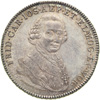 |
German States -- Mainz. Taler, 1794. Dav-2430; Cr-99a. Friedrich Karl Joseph von Erthal. Bust three-quarters facing. Reverse: Capped arms. Light golden gray toning with lovely iridescent hues, luster peeking out around letters of the legend; an original and beautiful coin. NGC graded MS-64.
During the French Revolution, French troops besieged and captured Mainz, and proclaimed it the Republic of Mainz. It lasted only a short time as the Prussians next besieged the city and captured its defenders. Friedrich Karl Joseph had fled but returned with Prussian support. In 1797, Napoleon retook Mainz, adding to its "multi-national" flavor.
Estimated Value $1,250 - 1,500.
Ex Irving Goodman Collection.
View details and enlarged photos
| Realized
$2,760 |
Lot 626 |
 |
German States -- Mainz. Taler, 1794. Dav-2432A; Walther-649; KM-101a. Friedrich Karl Joseph von Erthal. Capped arms. Reverse: Value and date within sprays, "F S" under arms. Reflective surfaces with lovely iridescent toning. A handsome piece of understated stylistic elegance. NGC graded MS-62.
Estimated Value $1,200 - 1,500.
Ex Irving Goodman Collection.
View details and enlarged photos
| Realized
$1,380 |
Lot 627 |
 |
Mansfeld. Ducat, 1687. Fr-1573; KM-135. 3.44 grams. 22.22 mm. Franz Maximilian and Heinrich Franz, 1644-1692. Obv. St. George slaying the dragon. Leg: .FRAZ.MAX.HEINR.FRANZ.COMITIN MANSFELT Reverse Crowned arms within chain of the Golden Fleece. Leg: .NOB.DOM.INHELD -- UNGEN.SEB.E.SER. NGC graded AU-55.
Mansfeld is an example of how an ancient noble family can be ruined by hereditary divisions. The original Mansfeld, located north of Saxony, stems from the eleventh century. Yet the county was subdivided so many times, that it lost its power and prestige. Located in the Harz Mountains, large deposits of silver produced tremendous numbers of silver coins, but few gold ones. This is a tough coin to find.
Estimated Value $1,250 - 1,500.
(*).
View details and enlarged photos
| Realized
$1,840 |
Lot 628 |
 |
German States -- Mansfeld. Taler, 1774. Dav-2438; J-2; KM-151. Henry, Prince of Fondi. Crowned and mantled arms. Reverse: mounted St George spearing dragon. Adjustment marks on edge but stuck on a broad flan, with crisp details on the horse and dragon especially. Deeply toned in shades of gray and mauve. A beautiful example of this coinage. NGC graded MS-64.
The success of Stephen of Schlick's large silver joachimsthaler prompted a great many of the German princes and cities to follow suit and coin their own large silver talers. Among the first were the counts of Mansfeld, who began issuing in 1521. Their mines were productive, not as spectacularly as those of the Joachimsthal owned by the Schlicks, but far longer lived, and ultimately one of the better producing locations in Germany. Their coinage was distinctive, beautifully styled of fine engraving, but the issues were repetitive as nearly all the talers bear a coat of arms and the motif of St George and the dragon. One- and two-taler denominations predominated, with an occasional three or four talers appearing now and again, plus a trade ducat in gold. All coinage came to an end with the extinction of the line in 1780, just six years after this coin was minted.
Estimated Value $700 - 800.
Ex Irving Goodman Collection.
View details and enlarged photos
| Realized
$2,220 |
Lot 629 |
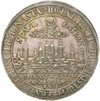 |
German States -- Münster. Taler, 1661. Dav-5603; KM-75. Struck on particularly broad flan. Haloed St Paul in clouds over city view. Reverse: Helmeted arms. Beautiful golden and pinkish gray toning. NGC graded MS-62.
Bishop von Galen, who issued this coin, took the city by force the year before, for the Catholic Counter Reformation, and re-established the bishopric seat there.
Estimated Value $500 - 600.
Ex Irving Goodman Collection.
View details and enlarged photos
| Realized
$1,093 |
Lot 630 |
 |
Nuremberg. Goldgulden, 1536. Fr-1801; Kellner-12. 3.21 Grams. 24.03 mm. Saint Lawrence with halo, head and feet breaking legend at top and bottom. Book in left and right holding grate over shoulder. Leg: SANCTVS* - LAVRENTIVS -. Date in field on either side of saint. Reverse Eagle left breaking inner circle. Leg: NVRENBERG* - MONE*REIPVB. Boldly struck with considerable mint luster. NGC graded AU-55.
This type comes both dated and undated. Dated examples such as this one command significant premiums. St. Lawrence, being the patron saint of the city is prominently displayed.
Estimated Value $1,500 - 2,000.
(*).
View details and enlarged photos
| Unsold |
Lot 631 |
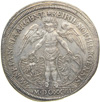 |
German States -- Nuremberg. 2 Talers, 1627. Dav-A5640; Kel-224; KM-83. 58.10 grams. Winged cherub holding two shields, date in roman numerals below. Reverse: Ferdinand II, shown as an equestrian figure. Generally well detailed, struck on a large flan with some of the denticle rim off flan. Lovely gray toning with considerable original mint luster. Very rare. NGC graded AU-55.
More than just a market town, Nuremberg (along with Augsburg) was a magnet for craftsmen and skilled inventors and became renowned as a center of manufacturing of precision scientific instruments, one of which was the astrolabe. In the early days of transoceanic navigation it was not possible to determine longitude at sea, but it was quite easy to determine latitude. To go to a place of known latitude, the ship was sailed to that latitude and then sailed east or west along the latitude line until the destination was reached. However, mariners, if sufficiently skilled in navigation, could use the astrolabe to determine latitude, longitude and time of day, among other calculations. Thus, using an astrolabe on the European voyages of discovery in the 15th century was of utmost significance. The device would remain important until the invention of the sextant in the 18th century.
Estimated Value $4,000 - 5,000.
Ex Irving Goodman Collection.
View details and enlarged photos
| Realized
$4,830 |
Lot 632 |
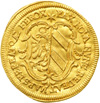 |
Nuremberg. Ducat, 1635. Fr-1828; Kellner-54. 3.36 grams. 24.20 mm. City coinage (1635-1645). Mintmaster (star) Hans Christoph Lauer, 1619-1639. Obv: City coat of arms. Leg: PAX.NOVA.NVNS.REDEAT.MARS.PEREATQAE.FEROX. Reverse Decorated Square cartouche within. Leg: MONETA/AVREA/REIPVB:/NORIB/1635. NGC graded MS-63.
Not that rare of a type, but of exceptional quality.
Estimated Value $1,500 - 1,750.
(*).
View details and enlarged photos
| Realized
$2,013 |
Lot 633 |
 |
Nuremberg. Ducat, 1640. Fr-1826; Kellner-57. 3.47 grams. 22.09 mm. Date in chronogram. Obv. Eagle facing left. Leg: +DUCATUS REIPUB:NORIMBERGEN: Reverse Angel head behind two shields. Leg: sIt DeVs aVXILIVM tVta sIt Ipse saLvs*. NGC graded MS-63.
The date being in chronogram means that the larger letters in the legend are all Roman Numerals, and if added together, total 1640. A very clever way of dating coins.
Estimated Value $4,000 - 5,000.
(*).
View details and enlarged photos
| Unsold |
Lot 634 |
 |
Nuremberg. Ducat, 1649. Fr-1833; KM-159; Kellner-60. 3.45 grams. 22.31 mm. Obv. Three shields of arms. Leg: +MONETA AUREA. REIPUB. NORINBERG: Reverse Paschal lamb on bible with banner. Leg: CHRISTO DUCE VERBO LUCE. NGC graded AU-55.
This is an example of the "Lamb Ducat" coinage of Nuremberg. A great design and a very popular type.
Estimated Value $1,000 - 1,250.
(*).
View details and enlarged photos
| Realized
$1,265 |
Lot 635 |
 |
Nuremberg. Ducat, 1650. Fr-1839; KM-168; Kellner-62. 3.46 grams. 23.25 mm. On the Peace of Westphalia. Obv. Eagle facing right. Hand from heaven holds wreath over eagles head. Leg: DVCATVS REIPVB NORIMBERG. Reverse Six-line inscription, above arms (shield) divide Roman numeral date at bottom. Leg: IMP. / FERDINAN.III/ P.F. AVGVSTO/ PACIS EXECVTIO/ DECRETA/ NORI - BERGAE/ MD -CL /16 - IVNI. Sharply struck with an abundance of original luster. NGC graded MS-63.
The Peace of Westphalia ended the Thirty Years War. Nuremberg was especially hard hit from the war, being occupied from Sweden. One must try to understand the incredible relief central Europe felt after thirty years of continuous devestation.
Estimated Value $2,000 - 2,500.
(*).
View details and enlarged photos
| Realized
$2,990 |
Lot 636 |
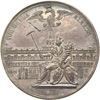 |
German States -- Nuremberg. Taler, ND (1688). Dav-5664; Kel-261; KM-204. Mintmaster Daniel Sigmund Dockler. Eagle, city hall, seated figure of Nuremberg. Reverse: City view. Prooflike fields, fully lustrous with lovely steel-gray and iridescent colors. Very rare. NGC graded MS-64.
This is known as a Rathaus Taler. Rathaus is the German word for City Hall, and the City Hall of Nuremberg is prominently displayed on this Taler. City views became popular in the 16th century because they were especially well suited to the new, large-format coins.
Estimated Value $4,000 - 5,000.
Ex Irving Goodman Collection.
View details and enlarged photos
| Realized
$7,188 |
Lot 637 |
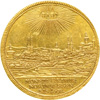 |
German States -- Nuremberg. Gold 5 Ducats, 1698 (date in Chronogram). Fr-1873; Erlanger-576; Kellner-266; KM-232. 17.37 grams. Leopold I, 1658-1705. On the anniversary of the Peace of Rijswik. Sunburst above view of Nuremberg seen from the east. Reverse: Peace standing frontal on base, holding branch and caduceus, two putti below supporting shields of arms; initials "GFN" on base (for mintmaster Georg Friedrich Nurnberger, 1677-1716). Exemplary strike, with lustrous devices on prooflike fields. Scattered, generally light marks. An especially fine example of this large gold issue. Very rare. NGC graded MS-62.
The word "chronogram" refers to the date being displayed within the words via the use of roman numerals. In this instance, the numerals "M D C L X X X X V I I I" are found within the legend.
Estimated Value $10,000 - 12,500.
Illustrated in Money of The World, coin 98.
View details and enlarged photos
| Realized
$20,125 |
Lot 638 |
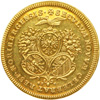 |
German States -- Nuremberg. Gold Double Ducat, 1700 (in chronogram). Fr-1882; Kellner-51. 6.96 grams. Floriated ornate cartouche, bearing three shields of arms, eagle above. Reverse: Pascal lamb left, holding banner, atop globe. An especially choice example exhibiting an even, bold strike, on reflective fields. Some faint scattered hairlines, mainly limited to the reverse fields. Obverse with appealing old reddish toning. NGC graded MS-62.
The pascal lamb, pictured here, is the lamb which God commanded the Israelites in Egypt to eat in order to avoid the ten plagues. In fact, the blood of the slain lamb was to be smeared on the doorposts of the Israelites to inform the angel of death to pass over their houses in the slaying of the first born. The sacred image was carried forth and became an enduring Christian motif as well.
Estimated Value $1,000 - 1,200.
View details and enlarged photos
| Realized
$1,500 |
Lot 639 |
 |
German States -- Nuremberg. 2 Reichstalers, ND (1706). Dav-2473; Kel-227. 58.38 grams. Emperor Joseph I, 1705-1711. Mintmaster George Friedrich; dies by George Hautsch. Aerial view of city, with three winged cherubs supporting three garnished shields of arms. Reverse: Laureate, draped and cuirassed bust of Joseph I right. A coin of dramatic eye appeal, the strike sharply detailed, with lustrous devices on prooflike fields, all offset by broad denticles serving to "enfold" the images. Lovely gray toning, iridescent in hues of pink and russet. Very rare, and unusually choice. NGC graded MS-63.
Joseph I was one of the most able of the Habsburg Emperors. He won numerous battles against the aggressive Louis XIV of France, abolished many of the arbitrary and harsh edicts of his father, Leopold I, and advanced the study of art and science in his court. His premature death via smallpox in 1711 was a harsh blow to the success of the Habsburgs.
Estimated Value $10,000 - 12,500.
View details and enlarged photos
| Realized
$14,950 |
Lot 640 |
 |
German States -- Nuremberg. Taler, 1711. Dav-2475; Kellner-268. Georg Friedrich, mintmaster. 29.17 grams. Eagle with shields over city view. Reverse: Bust of Karl VI right with "GFN" below. Boldly struck and well centered. Gorgeous iridescent toning. Rare. NGC graded MS-65.
Karl succeeded more as a musician than as a statesman. He composed, played the harpsichord, and conducted the court band. Unfortunately, he performed those functions when he should have been leading the nation.
Estimated Value $2,500 - 3,000.
Ex Irving Goodman Collection.
View details and enlarged photos
| Realized
$4,830 |
Lot 641 |
 |
German States -- Nuremberg. Taler, 1721. Dav-2476; Kellner-26. Mintmaster, Paul Gottlieb Nurnberger. 29.17 grams. Eagle over city view. Reverse: Bust of Karl VI right. Date in chronogram. Prooflike fields, with beautiful deep iridescent toning. NGC graded MS-63.
In 1050 "Nourenberc" was first officially mentioned in documents, the site essentially being a castle and surrounding estates. By the end of the 13th century, it was made a free imperial city. Hosting a steady stream of pilgrims to the grave of the miracle-working Saint Sebald, Nuremberg soon became one of the great trade centers on the route from Italy to northern Europe.
Estimated Value $1,250 - 1,500.
Ex Irving Goodman Collection.
View details and enlarged photos
| Realized
$1,610 |
Lot 642 |
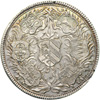 |
German States -- Nuremberg. Reichstaler, 1733. Dav-2480; Kellner-270; Erlanger-688. 29.12 grams. Karl VI, 1711-1740. Wreath bearing six shields of arms, with larger seventh shield depending from ribbon at center. Reverse: Battery of four cannons firing at large round target in field; date of June 8, 1733, below. Edge legend: EIN* REICHS* THALER* NACH* ALTEN* SCHROT* UND* KORN. Small edge defect to flan at 12 o'clock, otherwise a superb strike, centered within broad denticles, intricately detailed. Fine engraving seeming to show the artillery animated. Softly lustrous devices on reflective fields, unusually choice. Pleasing light gray toning, colorfully iridescent in some areas. Rare. NGC graded MS-62.
Displayed on this coin is a fascinating scene highlighting the artillery contests conducted in the city in June of that year. The momentum for the War of Polish Succession (1733-1738) was moving forward and the various contestants were gearing up for the conflict. Emperor Karl VI raised, from Nuremberg, the 14th Infantry Regiment in November 1733 for service in the war. It was believed that artillery would play an important role in the conflict. Here we see the soldiers practicing for conflict, a rarely seen motif on coinage of any period.
Estimated Value $5,000 - 6,000.
Ex Auction S. Rosenberg, May 26, 1925, lot 1713; Illustrated in Money of The World, coin 99.
View details and enlarged photos
| Realized
$8,970 |
Lot 643 |
 |
German States -- Nuremberg. Taler, 1742. Dav-2482; Ke-272; Witt-1993. Paul Gottlieb of Nuremberg. City view. Reverse: Bust of Charles VII, 1742-1745. Light double striking. Lovely old gray toning with hints of olive green, with much luster. NGC graded MS-62.
Charles VII, also known as Karl Albrecht, elector of Bavaria, was actually a quasi emperor. Charles VI, through the Pragmatic Sanction, had arranged for his daughter, Maria Theresa, to be named Empress upon his death. Charles VII rejected this arrangement, obtained an army and marched on Vienna. He never conquered Vienna but he did arrange for his coronation as king of the Romans. His armies were defeated and he retreated and soon died. His rule was inconsequential and probably unlawful, but his coins are magnificent, as seen here. He was the only non-Habsburg to be crowned Emperor in 400 years!
Estimated Value $1,000 - 1,300.
Ex Irving Goodman Collection.
View details and enlarged photos
| Realized
$1,840 |
Lot 644 |
 |
German States -- Ottingen. Taler, 1759. Dav-2501; Lof-397; KM-18. Johann Aloys I, of Wallenstein-Spielberg, 1737-1780. Christian Ernst Muller, mintmaster. Bust of diminutive but fine style right. Reverse: Large crowned, supported shield with no mantle. Toned in shades of lilac, mauve and greenish gray. Rare. NGC graded MS-63.
Oettingen was a small town with one castle in southern Bavaria. Its main claim to fame was the presence of the "Miraculous Image of Our Lady" in the chapel of the abbey. Hundreds of thousands of pilgrims visited annually but very few coins were ever produced there. This is a great rarity.
Estimated Value $2,000 - 2,500.
Ex Irving Goodman Collection.
View details and enlarged photos
| Realized
$2,415 |
Lot 645 |
 |
German States -- Passau. Taler, 1703 (Regensburg). Dav-2518; Kellner-106. John Philipp, Graf von Lamberg, 1689-1712. Cardinal in hat right, "SEIZ" below bust. Reverse: Capped arms. Beautiful old iridescent toning. Broadly struck with exquisite detail. A splendid example. NGC graded MS-62.
Passau was another of those bishoprics where the bishop was supposed to be concerned with the welfare of the people, but in actuality mostly ignored them. Numerous conflicts arose between the townspeople and the bishop. Passau was also a great sword and blade manufacturing center. In fact, the blades were stamped with the Passau wolf (seen on the shield of this taler), which many swordsmen believed granted them invulnerability.
Estimated Value $2,000 - 2,500.
Ex Irving Goodman Collection.
View details and enlarged photos
| Realized
$2,415 |
Lot 646 |
 |
German States -- Passau. Taler, 1712. Dav-2520; Kel-108. John Philipp, Graf von Lamberg, 1689-1712. Bust of Cardinal right. Reverse: Capped arms. Lovely iridescent toning with reflective surfaces. Rare. NGC graded MS-63.
Again we glimpse images of the famed Passau wolf on this coin's shield.
Estimated Value $1,250 - 1,500.
Ex Irving Goodman Collection.
View details and enlarged photos
| Realized
$2,760 |
Lot 647 |
 |
German States -- Passau. Taler, 1779. Dav-2525; Kel-126; Cr-8. Leopold Ernst, Graf von Firmian, 1763-1783. "H.ST" for Heinrich Straub. Bust of Cardinal right. Reverse: Capped elegant arms. Fully lustrous with gorgeous old iridescent toning. Luster peeks around the letters of the legend, indicative of originality. Rare this nice. NGC graded MS-65.
Leopold Ernst did one great thing of note. As advisor to Empress Maria Theresa on matters of education, he established compulsory schooling in the Holy Roman Empire (for males only: women and the poor were of course excluded in that age).
Estimated Value $2,500 - 3,000.
Ex Irving Goodman Collection.
View details and enlarged photos
| Realized
$4,485 |
Lot 648 |
 |
Pfalz-Simmern. Ducat, 1577. Fr-2051. 3.47 grams. 23.27 mm. Richard, 1569-1598. Obv. Count standing, sword in right hand on right shoulder, left hand on sword hilt. Leg: RICHA.D.G.C. - PA - .RHE. DVX.BA. Reverse Arms, value at bottom and two digit date. Mintmark at top, hat. Leg: MO.NO.AVRE. (in circle) (1/Dr) SIMERENSIS. Lovely original mint luster. NGC graded MS-62.
Pfalz, located in the Baden Wurttemberg region, was one of the seven Electors of the Holy Roman Empire. In fact, the count held the additional title of steward to the emperor. The Simmern subdivision, was actually the one who inherited the electoral right. This is a scarce and important coin.
Estimated Value $2,500 - 3,000.
(*).
View details and enlarged photos
| Unsold |
Lot 649 |
 |
German States -- Pfalz-Zweibrücken-Veldenz. Taler, 1623. Dav-7188; KM-22. Johann II, 1604-1635. Head right. Reverse: Helmeted arms. Superbly struck with original mint luster, great color, and qualitiy surfaces. Rare in this marvelous state of preservation. NGC graded MS-64.
Pfalz translates to English as the Palatinate, an area of western Germany north of Baden and Wurttemberg whose ruler was also one of the seven electors of the empire, and was also the prestigious steward to the emperor.
Estimated Value $1,500 - 1,750.
Ex Irving Goodman Collection.
View details and enlarged photos
| Realized
$2,415 |
Lot 650 |
 |
German States. Pommern (Pomerania), under Swedish rule. Gold 2 Ducats, 1706. Fr-2118; Hilderbrand I p. 542, 107; KM-M5. 6.93 grams. Karl XII, 1697-1718. Die engraver: J. Memmius of Stettin. Karl standing right, hair upswept, in fur-lined jacket with large boss-like buttons, clutching a short baton, or telescope, with other hand on sword. Reverse: Lion standing on ledge left between two pillars, toppling one, the second already broken, 1706 below; CONCVSSIT VTRAMQVE. Finely centered, sharp portrait, full strike. Faint red toning in the recesses, over residual luster. Interesting "naïve" art and imagery. Very rare. NGC graded MS-62.
Pomerania is today part Polish and part German; during the Thirty Years War it was conquered by Sweden and remained in Swedish hands until 1720.
Estimated Value $9,000 - 10,000.
Illustrated in Money of The World, coin 116.
View details and enlarged photos
| Realized
$14,375 |
Lot 651 |
 |
German States -- Prussia. Friedrick d'Or, 1749-ALS (Berlin). Fr-2382; Old-379; v. Schr-13. Friedrich II, The Great, 1740-1786. Cuirassed and draped bust left. Reverse: Crowned eagle on war gear, with flanking eagle-topped standards and crown above; date below right. Mottled toning on brilliant and fully lustrous fields. Superb strike from elegantly engraved dies. Prooflike fields. And a marvelous portrait. Of the Highest Rarity! NGC graded MS-63.
Friedrich was one of the greatest leaders in Europe in the 18th century. He modernized his country and developed Prussia into a leading European power. His military genius was renowned. Napoleon, who admired Friedrich, went to visit his tomb in Potsdam, and said of Friedrich, "If this man were still alive, I would not be here."
Estimated Value $12,500 - 15,000.
View details and enlarged photos
| Realized
$25,300 |
Lot 652 |
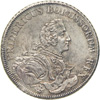 |
German States -- Prussia. Taler or Piastre (1751). Dav-2591; v.Schr-1651; Old-368. Cleve mint. Friedrich II, The Great, 1740-1786. Bust right. Reverse: Crowned eagle above supported arms with motto on band below. Issued for the Royal Prussian Asiatic Society. Very rare. A fabulous specimen of elegant engraving, sharply struck on a superior flan of excellent metal, with old-time elegant iridescent gray toning. NGC graded MS-64.
Friedrich was as good a diplomat as he was a soldier. He ended up doubling the size of his territories. The acquisiion of Silesia and East Prussia made his kingdom one of the greatest in Europe. His diplomatic skills enabled him to play Russia against the Habsburgs and assure European approval of his new territories. This marvelous "Piastre" of his captures the spirit of his realm perfectly.
Estimated Value $5,000 - 6,000.
Ex Irving Goodman Collection.
View details and enlarged photos
| Realized
$11,500 |
Lot 653 |
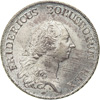 |
German States -- Prussia. Taler, 1771-A. Dav-2586; v.Schr-457; KM-306.1. Friedrich II, The Great. Bare head right. Reverse: Crowned eagle perched upon a firing cannon, divided date below. Mottled but delightful iridescent silvery lilac gray toning on brilliant and fully lustrous fields. Very rare this choice. NGC graded MS-66.
Frederick the Great (1740-1786) was one of the true movers and shakers among his European contemporaries. An "enlightened despot," he was molded under the harsh tutelage of an intemperate father, yet his personality was held to be one of the wonders of his time. Tolerant in religious matters, he professed atheism to his closest intimates. Cold and curt, he was known for a wit that was biting and icy. He wrote about politics, history, military science and philosophy, and his works were well regarded by his contemporaries; his military essays are still considered classics. A musical pupil of Quantz, he played the flute with some ability, as well as composing marches and other works for that instrument. He offered Mozart the position of court conductor at Berlin, at a very handsome salary of three thousand talers, but Mozart refused on patriotic grounds because of the continuing enmity between Prussia and Austria. Perhaps Mozart was holding one of these military talers when he said no to Friedrich!
Estimated Value $3,000 - 3,500.
Ex Irving Goodman Collection.
View details and enlarged photos
| Realized
$5,750 |
Lot 654 |
 |
German States -- Prussia. Reichstaler, 1776-A. Dav-2590; Old-70; v.Schr-462. Berlin mint. Friedrich II, The Great, 1740-1786. Laureate aged bust right. Reverse: Crowned eagle resting on armaments, including a cannon, date below. Breast of eagle a little soft, otherwise a choice strike. Fields and devices with muted satiny luster under very light toning. Especially nice for one of these, sometimes called "blood talers" because they were carried by Prussian soldiers paid by the British to fight in the American colonies during the American Revolutionary War. NGC graded MS-62.
Frederick continued his father's fundamental domestic policies. His chief priority was the care, strength and discipline of his army. Nevertheless, he instituted important legal and penal reforms, promoted education and accomplished internal improvements such as drainage projects, roads and canals. He also set up various trade monopolies to help create new industries within the country. Externally, he made war and territorial acquisition the prime instrument of his foreign policy for at least twenty-five years (his consistent jousting with Maria Theresa of Austria for territorial gains was the root cause of the Seven Years War, which was played out concurrently in the French and Indian War of America). After that, he resorted to diplomatic "brigandage" to accomplish the same ends. Note the "magical date" of this coin for American numismatists.
Estimated Value $800 - 900.
View details and enlarged photos
| Realized
$1,150 |
Lot 655 |
 |
German States -- Prussia. Friedrich d'Or, 1798-A. Fr-2422; v.Schr-9; C-117. 6.66 grams. Berlin mint. Friedrich William III, 1797-1840. Uniformed bust left. Reverse: Eagle on wide groundline, wings open and holding branch and laurel, date below. Satiny devices on prooflike fields. A touch of cabinet friction seen on reverse, but still a choice example. NGC graded MS-63.
Friedrich Wilhelm III was one of the least effective kings of Prussia. His tendency toward indecisiveness, and need to micro-manage, effectively crippled his administration. His military failures led to Napoleon's success. It was only at the Congress of Vienna in 1815 that Prussian authority was restored.
Estimated Value $1,500 - 2,000.
View details and enlarged photos
| Realized
$1,898 |
Lot 656 |
 |
German States -- Prussia. Taler, 1814-A. Dav-756; Th-244; J-33; KM-387. Friedrich Wilhelm III. Bare head right. Reverse: Value and date within wreath. Full original mint luster beneath a light gray tone with iridescent hues. NGC graded MS-63.
A Napoleonic period issue, this coin competed with the French 5 Franc for European commerce.
Estimated Value $800 - 1,000.
Ex Irving Goodman Collection.
View details and enlarged photos
| Realized
$920 |
Lot 657 |
 |
Rantzau. Ducat, 1656. Fr-2449. 3.46 grams. 23.35 mm. Count Christian I, 1650-1663. Obv: Bust right. Leg: CHRISTIAN.COM.IN RANTZ. DOM.IN BREITENB. Reverse Complex coat of arms. Leg: DEO DUCE COMITE FORTVNA. A great rarity. NGC graded AU-58.
Rantzau is a small county in Schleswig Holstein. The count controlled one castle at Breitenburg. The area was constantly in conflict between German and Danish claims. In 1656, the Germans were in control, and a few gold ducats were produced. One can go years without seeing a Rantzau ducat.
Estimated Value $15,000 - 20,000.
(*).
View details and enlarged photos
| Unsold |
Lot 658 |
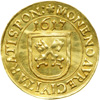 |
Regensburg. Goldgulden, 1617. Fr-2456; Beck-106. 3.22 grams. 23.33 mm. Obv. City arms with date above. Leg: *MONENO AVRE CIVITA RATISPON* Reverse Double headed eagle with crown above. Title in the name of Matthias. Leg: MATHIAE* ROM* IMP. AVG. P.F.DEC* Original mint fresh luster. Superb quality of this very rare type. NGC graded MS-63 Prooflike.
Another great rarity of Regensburg's early city coinage. Title of the Holy Roman Emperor, Matthias, who bestowed the mint right upon the city. Regensburg at this time was the most prosperous city of southern Germany.
Estimated Value $10,000 - 12,000.
(*).
View details and enlarged photos
| Unsold |
Lot 659 |
 |
Regensburg. Ducat, 1642. Fr-2469; KM-104. 3.47 grams. 21.91 mm. Obv: Five line inscription, arms divide date at top. Leg: DASIVBELFEST/ MANIEUTBEGETA/ GOTTGEBSAVCH/DERPOSTERITAT/ *S.P.Q.R.* Reverse Candle above Bible on stand, banner at top. Leg: V.D.M.I.AE/ .DEN.XV.(S.B.) OCTOB: Struck to commemorate the Reformation. NGC graded MS-61.
This coin was struck to celebrate the Reformation in Germany. An indication of the importance the city attached to its Protestant status.
Estimated Value $3,000 - 3,500.
(*).
View details and enlarged photos
| Realized
$4,830 |
Lot 660 |
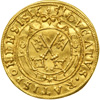 |
Regensburg. Ducat, 1651. Fr-2466; Beck-417; KM-91. 3.47 grams. 21.8 mm. Obv. City arms, crossed keys in cartouche in inner circle, date and legend. Leg: DVCATVS. RATISPONENSIS. 1651. Reverse Double eagle. Title in the name of Ferdinand III. Leg: *FERDI: III. D.G.ROM.IMP.SEM.AVGV.Rare. NGC graded MS-62.
Another city ducat of Regensburg, and another great rarity. The crossed keys are found on many of Regensburg's coins. During this period of economic stagnation, commerce was minimal so few gold coins were minted.
Estimated Value $10,000 - 12,500.
(*).
View details and enlarged photos
| Unsold |
Lot 661 |
 |
Regensburg. Ducat, 1657-HF. Fr-2466; Beck-424; KM-91. 3.47 grams. 21.8 mm. Obv. City arms, crossed keys in cartouche in inner circle, date and legend. Leg: DVCATVS. RATISPONENSIS. 1657 Reverse Double eagle. Title in the name of Ferdinand III. Leg: *FERDI: III. D.G.ROM.IMP.SEM.AVG. Rare. NGC graded MS-62.
Estimated Value $8,000 - 9,000.
(*).
View details and enlarged photos
| Unsold |
Lot 662 |
 |
German States -- Regensburg. Taler, 1696. Dav-5773; Beckb-6160; Plato-135; KM-203. Angel above arms in frame. Reverse: Eagle with heart-shaped shield on breast. Handsomely toned in shades of silvery gray and pinkish blue, with reflective surfaces. Scarce in this exceptional state of preservation. NGC graded MS-64.
Regensburg was one of those conflicted areas of Europe. Its early bridge across the Danube enabled the city to become an important trade center between northern Europe and Venice. The city also was the home of a major bishopric. The conflict occurred between the Catholic bishopric and Protestant city. The example pictured here is of the city coinage bearing the Latin city name, "Ratisbon."
Estimated Value $1,500 - 1,800.
Ex Irving Goodman Collection.
View details and enlarged photos
| Realized
$1,898 |
Lot 663 |
 |
German States -- Regensburg. Gold 3 Ducats, ND-B (after 1745). Fr-2536; Beckenbauer 317; Plato --. 10.44 grams. Franz I, 1745-1765. Mintmaster, Johann Christoph Busch; die engraver Johann L. Oexlein. Aerial city view from the northeast. Reverse: Laureate, cuirassed and draped bust of Franz I right. Minor planchet flaw behind portrait. A few handling marks, otherwise a sharp strike with prooflike fields as so designated by the grading service. Lustrous and choice for issue. Very rare. NGC graded MS-62 Prooflike.
Estimated Value $9,000 - 10,000.
Plate coin in Krause, World Coins, 1701-1800, First Edition, p. 416.
View details and enlarged photos
| Realized
$17,400 |
Lot 664 |
 |
German States -- Regensburg. Gold Ducat, ND-IBC. KM-306. Franz I, 1745-1765. Detailed city view showing the many towers of Regensburg, its river and bridges, the sun shining upon the industry of the place, and the keys to the city below. Reverse: Laureate, cuirassed and draped bust of Franz I right. An exquisite piece, sharply struck and glowing with luster, all "framed" by deep, wide denticles -- the very picture of successful commerce and human progress. NGC graded MS-64 Prooflike.
Husband to Maria Theresa and father of their sixteen children, Franz essentially left the governing in his wife's capable hands, although he was also Grand Duke of Tuscany. Here we see an excellent example of their trade Ducat. These little "golden views" of the city were certainly an inducement to think of the city in terms of its offered "golden" opportunities.
Estimated Value $1,250 - 1,500.
View details and enlarged photos
| Realized
$3,105 |
Lot 665 |
 |
German States -- Regensburg. Taler, 1759. Dav-2619; Beckb-7104; Plato-147; KM-374. Johann Christoph Busch, mintmaster. Crossed keys to the city within floriate cartouche, date below exergue line. Reverse: Bust of Francis I right. Centered, with large rims, and purple iridescent toning offsets the superb craftsmanship of this sharply minted coin. NGC graded MS-61.
This a "Convention Thaler," made only a few years after the 1753 Convention, and likewise showing its value in terms of the Fine Mark of Cologne.
Estimated Value $600 - 700.
Ex Irving Goodman Collection.
View details and enlarged photos
| Realized
$978 |
Lot 666 |
 |
German States -- Regensburg. Gold 8 Ducats, ND-ICB (after 1773). Fr-2558; Beckenbauer-221; Plato --. 27.91 grams. Joseph II, 1765-1790. Johann Christoph Busch, mintmaster. Obverse die engraver Johann L. Oexlein; reverse, Johann N. Koernlein. Aerial city view from the north, bridges across robust river. Reverse: Crowned, double-headed eagle holding sword and globus cruciger, crowned shield and order at breast. Light handling marks, otherwise exceptionally sharp with prooflike fields, the devices satiny to matte with frosted relief. Exemplary, and of the Highest Rarity. NGC graded MS-63 Prooflike.
The city of Regensburg, located at the confluence of the Danube and Regen Rivers, was the permanent home of the Reichstag of the Holy Roman Empire, ensuring it a permanent, wealthy administrative class as well as a constant flow of important visitors. A close examination of the city view on this marvelous and extremely rare coin gives one a glimpse of that wealth.
Estimated Value $35,000 - 40,000.
Illustrated in Money of The World, coin 100.
View details and enlarged photos
| Realized
$63,250 |
Lot 667 |
 |
German States -- Regensburg. Ducat, ND-GCB (after 1773). Fr-2540; Beckenbauer-510; Plato --. 3.49 grams. Joseph II, 1765-1790. Mintmaster, Georg Christoph Busch; die engraver, Johann N. Koernlein. Aerial city view from the northeast. Reverse: Laureate bust of Joseph II right. Sharp, with brilliant prooflike fields, and satiny to matte semi-cameo devices. Handling marks or wear very light. Very rare. NGC graded MS-62 Prooflike.
Joseph II, oldest son of Franz and Maria Theresa, was a true man of his age. His fanatical belief in Enlightened Despotism produced wonderful egalitarian trends but few concrete results.
Estimated Value $4,000 - 5,000.
View details and enlarged photos
| Realized
$4,600 |
Lot 668 |
 |
German States -- Regensburg. Taler, 1775. Dav-2626; Beckb-7114; Plato-154; KM-428. Mintmaster, Georg Christoph Busch. City view. Reverse: Bust of Joseph II right. Natural flan crack near edge. Fully lustrous with lovely iridescent toning of purple and blue colors. NGC graded MS-62.
Estimated Value $1,500 - 2,000.
Ex Irving Goodman Collection.
View details and enlarged photos
| Realized
$1,725 |
Lot 669 |
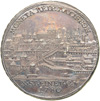 |
German States -- Regensburg. Taler, 1780. Dav-2627; Beckb-7116; KM-436. Mintmaster, Georg Christoph Busch. City view. Reverse: Bust of Joseph II right. Lovely deep mauve and blue iridescent toning. NGC graded MS-63.
Joseph failed in virtually all of his ambitious plans. His low point was probably reached when he commanded an army against the Ottoman Turks, and his army panicked and fled upon hearing of an advancing army which did not exist. He wanted this motto placed on his tomb: "Here lies Joseph II, who failed in all he undertook."
Estimated Value $700 - 800.
Ex Irving Goodman Collection.
View details and enlarged photos
| Realized
$978 |
|
|